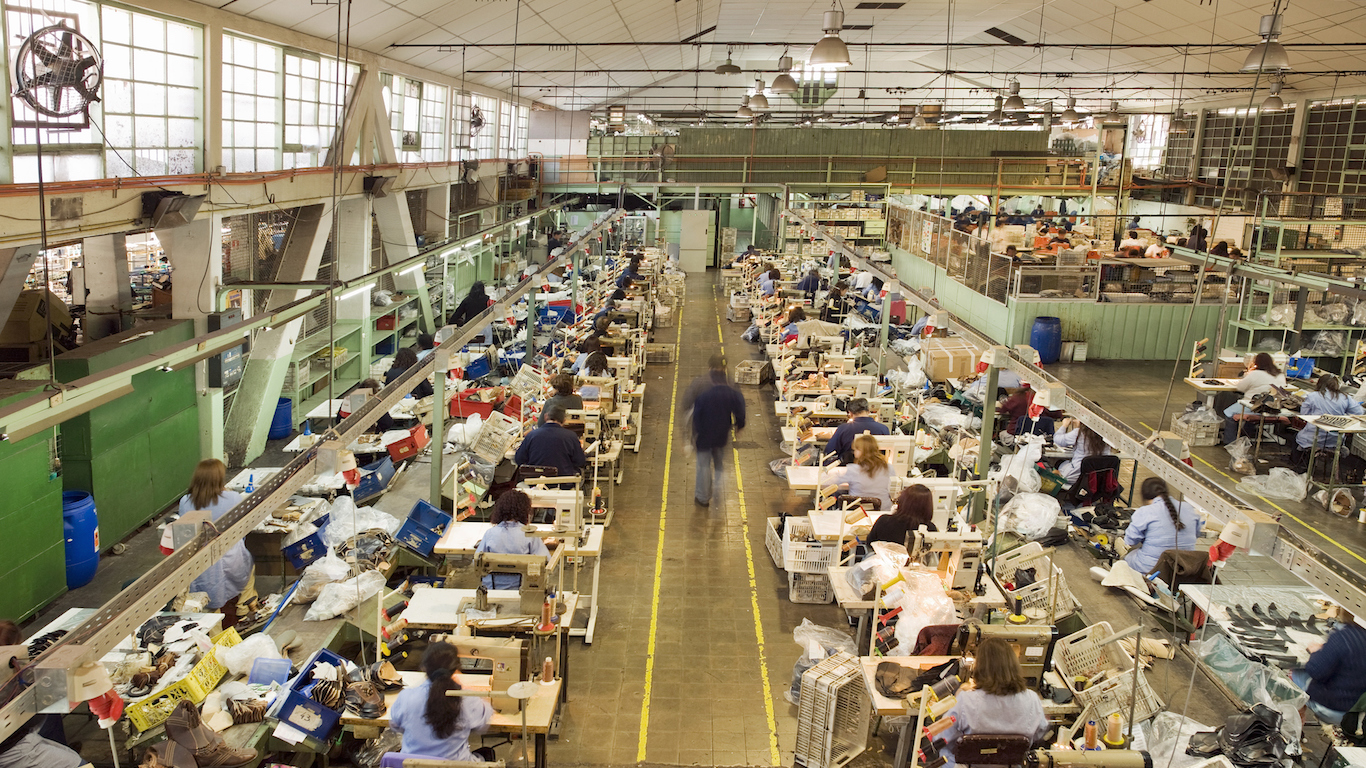Special Report
America's 25 Dying Industries

Published:
Last Updated:

Valued at nearly $20 trillion, the U.S. economy is the largest in the world. Maintaining a competitive edge necessitates remaining diversified and dynamic. While this means that some U.S. industries thrive, others inevitably decline or are rendered obsolete.
As certain industries fade, so do hundreds of thousands of American jobs. 24/7 Wall St. analyzed employment figures from 2006 to 2015 from the Bureau of Labor Statistics to determine the 25 fastest dying industries. Employment in each industry on this list declined by at least 43%, and in the top two by at least 80%.
At least one of three broad factors is behind the decline in each of the fastest dying industries. The first factor is cost reduction. Cheaper labor abroad has caused many American companies to outsource manufacturing operations. In China, for example, the minimum monthly wage in the garment industry is less than $150 a month. Perhaps not surprisingly, the bulk of clothing Americans import was made in China.
Click here to see America’s 25 dying industries.
Click here to see America’s 25 thriving industries.
In addition to outsourcing, robotic automation in U.S. factories have hurt employment in manufacturing. The sector has shed nearly 2 million jobs in the past decade, a 12.8% decline. Of the 25 fastest dying industries, 10 are in the manufacturing sector, and seven of those are related to clothing and other textiles.
The second cause for massive employment declines in certain industries is the wide adoption and exponential growth of new technologies. Online streaming services and on-demand programming are largely responsible for the 61% employment decline in DVD and video tape manufacturing and the 89% decline in the video rental industry. Similarly, the proliferation of cellphones and smartphones has greatly reduced employment in both telephone manufacturing and photofinishing, industries where employment has declined by 51% and 60%, respectively.
Finally, broad macroeconomic conditions have also contributed to lower employment in many industries. Most notably, within the last 10 years, the subprime mortgage crisis and resulting recession have contributed to a considerable drag on construction. Since 2006, new home construction has declined by 51%. Over the same time period, the broad construction sector has shed over a million jobs, or 15.3% of total employment. The land subdivision and framing industries were hit especially hard, with employment declining by 57% and 55%, respectively.
To identify the dying industries, 24/7 Wall St. reviewed employment growth from 2006 through last year for 704 U.S. industries in the fourth level of detail in The North American Industry Classification System (NAICS) by the U.S. Census Bureau. All data, including the number of establishments within each industry, average weekly and annual wages, as well as breakouts of these data over government, private, and local levels were retrieved from the U.S. Bureau of Labor Statistics’ (BLS) Quarterly Census of Employment and Wages (QCEW). The BLS tracks industry employment by tallying the number of workers in establishments whose primary sources of revenue fall within a given industry. As a result, a given establishment along with all of its employees may be reclassified depending on business decisions and market performance. For the finance and insurance industry, where the primary source of revenue for a fund, trust, or financial vehicle can change from a single trading decision, industry employee counts may not be comparable from one year to the next. To help ensure that 10-year employment changes reflected natural growth, all industries related to the management of funds, trusts, and other financial vehicles were excluded.
These are the America’s dying industries.

25. Knit fabric mills
> Employment change from 2006-2015: 43.0%
> Employment total: 6,642
> Wage growth from 2006-2015: 18.3%
> Avg. annual wage: $39,405
Knit fabric mills produce garments and other fabrics, manufacture lace, and often have dye operations. The U.S. textile industry has been declining for years. Since 1990, the employment decline in the garment manufacturing industry has outpaced that of any other manufacturing industry. Outsourcing these jobs to countries with less expensive labor, and increasing use of automation technology largely explain the employment drops.
[in-text-ad]

24. Masonry contractors
> Employment change from 2006-2015: -43.5%
> Employment total: 141,371
> Wage growth from 2006-2015: 25.2%
> Avg. annual wage: $43,430
Stone setting and bricklaying jobs are far less common now than they were 10 years ago. The number of masonry contractors working in the U.S. has dropped from a quarter million in 2006 to fewer than 142,000 last year. Masons often work on home construction projects, and the decline in new home construction following the housing crisis may partially account for the decline in masonry occupations. Close to 2 million residential construction projects were started in 2006. In 2009, during the recession, only 554,000 new homes were built. While new home construction has yet to return to pre-recession levels, housing-related professions like masons are projected to grow as the U.S. housing sector continues to recover.

23. Mortgage and nonmortgage loan brokers
> Employment change from 2006-2015: -44.8%
> Employment total: 80,210
> Wage growth from 2006-2015: 54.0%
> Avg. annual wage: $95,688
Jobs in loan and mortgage agencies and brokerages are on the decline in the United States. In the last 10 years, the number of industry workers has fallen by nearly 45%, one of the largest employment declines of any U.S. industry. Many mortgage establishments closed following the subprime mortgage crisis. Further, stricter regulations may have resulted in fewer mortgage approvals, which could be tied to the decline in mortgage broker employment. Under the new rules brokers also can no longer earn as much money. For this reason, some industry observers have suggested that interest in the mortgage loan broker profession has declined substantially.

22. Other depository credit intermediation
> Employment change from 2006-2015: -45.4%
> Employment total: 11,556
> Wage growth from 2006-2015: 31.0%
> Avg. annual wage: $74,359
There have been significant employment changes in the banking industry in the past decade as the industry itself has changed. Online banking and mobile apps have meaningfully reduced the need for tellers and many other banking operations that once required personal interaction. Workers in the other depository credit intermediation industry are employed at banking establishments other than mainstream commercial banks and credit unions. Total employment fell by nearly half over the last 10 years at such establishments, following ongoing industry consolidation. This decline is likely greater than at larger commercial banks because the number of small and industrial banks declined by about 28%, while the number of commercial banks fell by just 15%.

21. Private households
> Employment change from 2006-2015: -46.4%
> Employment total: 282,538
> Wage growth from 2006-2015: +46.3%
> Avg. annual wage: $23,870
The private household industry includes caretakers, maintenance workers, and gardeners, as well as butlers, maids, nannies, and cooks. The number of these workers has been effectively cut in half over the past decade. The decline may be due to a shift away from what some may view as an antiquated tradition of having live-in maids or servants.

20. Support activities for printing
> Employment change from 2006-2015: -46.7%
> Employment total: 26,378
> Wage growth from 2006-2015: 14.6%
> Avg. annual wage: $51,078
Much like the decline in the newspaper industry, employment decline in the printing support industry is largely the result of the proliferation of digital media. Jobs in the industry include tasks related to pre printing such as typesetting, and tasks related to post printing such as bookbinding and indexing. The increased demand for e-books and online media content has likely contributed to the decline in industry employment. Support activities for printing is one of several rapidly dying industries in the manufacturing sector.
[in-text-ad]

19. Manufactured, mobile, home dealers
> Employment change from 2006-2015: -47.0%
> Employment total: 12,833
> Wage growth from 2006-2015: 21.3%
> Avg. annual wage: $46,355
Manufactured home dealers sell mobile homes, or trailers, as well as related parts and equipment. The number of people working in the industry has declined by close to half in the past decade. Over that time, the number of mobile home dealerships also fell from about 4,100 to less than 2,300.
The mobile home industry does not typically benefit from housing booms — times when families prefer to buy standing homes — or from ensuing market crashes, as people during these times tend to be financially worse off. Further, as on-site built homes became much more affordable, mobile home parks were more likely to sell on-site units, eliminating the need for mobile home dealerships.

18. Broadwoven fabric mills
> Employment change from 2006-2015: -47.1%
> Employment total: 27,322
> Wage growth from 2006-2015: 25.1%
> Avg. annual wage: $42,888
The broadwoven fabric industry classification includes blanket, canvas, denim, and cotton fabric weaving. In the past decade, the number of Americans employed in the industry dropped from 51,653 to only 27,322. The broadwoven fabric industry is one of many suffering from a roughly three-decade long decline. The industry’s decline had an outsized effect on rural areas in the Southeastern United States.

17. Newspaper publishers
> Employment change from 2006-2015: -47.2%
> Employment total: 190,426
> Wage growth from 2006-2015: 18.5%
> Avg. annual wage: $48,413
With an increasing number of Americans finding their news through television and on the internet, the newspaper publishing industry is in decline. The share of adults who get news from social media alone has risen to more than 60%. In contrast, newspaper circulation in 2015 experienced its largest decline since 2009. In the past decade, employment in the industry has declined from about 361,000 to just above 190,000. Many smaller publishers have merged or been acquired by larger publishers as the industry is consolidating.

16. Satellite telecommunications
> Employment change from 2006-2015: -47.2%
> Employment total: 8,650
> Wage growth from 2006-2015: 25.1%
> Avg. annual wage: $103,840
With the growth of streaming services such as Netflix, HBO Now, Hulu, and more, cable and satellite television services have suffered. While the decline in television subscription has hurt sales, satellite communications has also likely suffered from the growth in the use of fiber optic communications, which can be more efficient for business-to-business communication than satellite. Total employment in the industry declined by 47% between 2006 and 2015.

15. Textile and fabric finishing mills
> Employment change from 2006-2015: -47.3%
> Employment total: 25,191
> Wage growth from 2006-2015: 24.7%
> Avg. annual wage: $43,733
Those who work in textile and fabric finishing mills add the final touches to clothes, such as bleaching, dyeing, and adding various types of artificial wear. Since 2000, the number of textile jobs in the United States fell by 46%. As is the case with many textile manufacturing jobs, both outsourcing and automation have contributed significantly to U.S. employment declines.
[in-text-ad]

14. Formal wear and costume rental
> Employment change from 2006-2015: -49.6%
> Employment total: 7,003
> Wage growth from 2006-2015: 36.4%
> Avg. annual wage: $27,954
The formal wear and costume rental industry is one of the many economic casualties of cheap foreign manufacturing imports. Because prices of such garments declined substantially, instead of renting a tuxedo or gown for black tie events, Americans have opted to buy their own formal wear in recent years. Many consumers are doing the same with Halloween costumes, choosing to buy inexpensive Chinese imports over costume rental. Nearly half of all formal wear and costume rental shops closed their doors over the past decade, as the total establishment count dropped from 2,100 in 2006 to 1,100 in 2015. Employment fell at the same pace.

13. Professional employer organizations
> Employment change from 2006-2015: -49.6%
> Employment total: 363,623
> Wage growth from 2006-2015: 32.1%
> Avg. annual wage: $41,625
Professional employer organizations, which include companies like ADP, manage some of the human resources needs for corporations. These companies manage payrolls, taxes, and handle former employees’ unemployment claims. In the past decade, employment in the industry has declined by nearly half. One reason for the industry’s decline may be the development of increasingly advanced software that allows businesses to handle their own human resources needs. Despite this employment drop, the number of establishments has actually declined by less than 5%.

12. Directory and mailing list publishers
> Employment change from 2006-2015: -50.5%
> Employment total: 22,146
> Wage growth from 2006-2015: 22.0%
> Avg. annual wage: $78,366
Mailing lists and contact directories can be invaluable for companies and marketing firms to reach large groups of individuals who might fit a certain demographic. Employment in the industry declined substantially, from 44,800 in 2006 to about 22,100 in 2015.
Likely one of the biggest factors in the decline of directory and mailing list publishing business is the development and widespread use of customer relationship management software such as Salesforce, which automatically generates targeted customer lists for companies. Revenue of the company tripled in the last five years and it now has more than 150,000 clients.

11. Curtain and linen mills
> Employment change from 2006-2015: -51.2%
> Employment total: 20,592
> Wage growth from 2006-2015: 27.5%
> Avg. annual wage: $35,753
The curtain and linen mill industry is on the decline, with employment dropping by more than 50% over the past decade, from roughly 42,000 to about 21,000. The number of facilities producing these goods fell from 2,396 in 2006 to less than 1,600 in 2015. Outsourcing is usually blamed for the decline in textile jobs in the United States, but improvements in robotics and other forms of automation are also partially to blame.

10. Telephone apparatus manufacturing
> Employment change from 2006-2015: -51.4%
> Employment total: 18,841
> Wage growth from 2006-2015: 23.1%
> Avg. annual wage: $115,196
Manufacturing of telephone apparatuses, including chord and wireless home telephones and telephone components, is a rapidly disappearing industry. Employment in the field has dropped from 38,700 in 2006 to less than 19,000 in 2015. The proliferation of mobile phones precipitated the industry’s decline. According to a study conducted by the Pew Research Center, 91% of American adults owned a cellphone in mid-2013, up from 65% in 2004. In addition to advancing technology, many jobs in the field have been outsourced as cheaper labor abroad allows manufacturers to maintain profit in the face of falling demand.
[in-text-ad]

9. Cut and sew apparel contractors
> Employment change from 2006-2015: -52.4%
> Employment total: 40,521
> Wage growth from 2006-2015: 34.4%
> Avg. annual wage: $31,027
Cut and sew apparel contractors are one of many apparel manufacturing sector sub industries to undergo rapid employment declines in the last decade. The number of cut and sew apparel contractors fell from more than 85,000 in 2006 to about 40,500 in 2015. In part because of cheap labor costs, many industry jobs that were once held in manufacturing hubs across America moved abroad. As of early 2014, the United States imported nearly 14 times more clothing than it exported. In China, the origin of the bulk of clothing Americans import, minimum wage in the garment industry is equivalent to less than $150 a month.

8. Framing contractors
> Employment change from 2006-2015: -55.0%
> Employment total: 73,208
> Wage growth from 2006-2015: 24.1%
> Avg. annual wage: $39,551
While employment declined by 15.3% in the broader construction industry, the number of framing contractors in the U.S. has declined by 55% in the past decade. The drop in industry employment has coincided with slowing demand for new homes. There were 162,851 framing contractors in 2006. That year, Americans built nearly 2.0 million new housing units. By 2015, there were only 73,208 framing contractors as 968,300 new homes were built.

7. Hosiery and sock mills
> Employment change from 2006-2015: -56.9%
> Employment total: 8,994
> Wage growth from 2006-2015: -14.7%
> Avg. annual wage: $30,678
Hosiery and sock mills are a prime example of a once-dominant American industry that is being automated and moving abroad. U.S. employment in the industry in the past decade has been more than halved from nearly 21,000 to less than 9,000 workers. In addition to eliminating jobs, competition from lower-wage labor abroad has also contributed to declining industry incomes. The average annual pay of an industry worker is only about $30,700, $5,300 less than the average pay in 2006.

6. Land subdivision
> Employment change from 2006-2015: -57.4%
> Employment total: 41,674
> Wage growth from 2006-2015: 16.9%
> Avg. annual wage: $79,154
Land subdivision entails dividing large segments of land into smaller plots to be sold to builders. Land is most often subdivided for residential construction. The 10-year 57.4% employment decline in the industry is likely linked to the dramatic slowdown in new home construction in the last 10 years. Americans built 2.0 million new homes in 2006, far more than the 968,300 new homes built in 2015. New home construction bottomed out in 2011, when only 585,000 new homes were completed in the United States.

5. Photofinishing
> Employment change from 2006-2015: -60.2%
> Employment total: 10,431
> Wage growth from 2006-2015: 60.9%
> Avg. annual wage: $52,373
Today, the vast majority of adults in the United States carry a mobile phone with a built-in digital camera. This modern convenience is partially to blame for steep employment declines in the photofinishing, or film developing, industry. In the past decade, the number of jobs in the industry has dropped by more than 60%, from 26,239 in 2006 to only 10,431 in 2015.
[in-text-ad]

4. Magnetic media manufacturing and reproducing
> Employment change from 2006-2015: -60.8%
> Employment total: 16,019
> Wage growth from 2006-2015: 56.4%
> Avg. annual wage: $105,555
The magnetic media manufacturing and reproducing industry entails the production of computer hard drives and DVDs. It also includes the manufacturing of antiquated data storage technology like floppy disks and video cassettes. In the last 10 years, solid state hard drives and cloud storage, as well as streaming services have made many once-dominant forms of magnetic media manufacturing obsolete. The number of industry jobs has declined from over 40,000 in 2006 to only about 16,000 last year.

3. Other apparel knitting mills
> Employment change from 2006-2015: -66.9%
> Employment total: 4,041
> Wage growth from 2006-2015: 23.0%
> Avg. annual wage: $33,875
The other apparel knitting mills industry classification primarily comprises underwear, outerwear, and nightwear fabric manufacturing. In addition to automation, which has made many industry jobs obsolete, low labor costs abroad has lead to the massive outsourcing of jobs across the broader apparel manufacturing sector. The number of Americans working in apparel knitting mills has dropped from 12,208 in 2006 to only 4,041 last year. The United States imported about $80 billion worth of clothing in 2013, while it exported less than $6 billion. China, which has one of the lowest minimum wages for garment workers of any country, is by far the largest manufacturer of clothing shipped to the United States.

2. Libraries and archives
> Employment change from 2006-2015: -80.0%
> Employment total: 32,992
> Wage growth from 2006-2015: 57.9%
> Avg. annual wage: $41,949
Employment in libraries and archives has declined by 80% in the last 10 years, more than in all but two other U.S. industries. It is no coincidence that declining employment in libraries and archives, like many fading industries, has coincided with the proliferation of the internet. Information that was once available only in libraries and archives is now accessible on personal computers in homes nationwide. According to the Pew Research Center, only about half of all American adults used the internet in 2000. By 2015, the share grew to 84%. Going forward, local government budget cuts will likely stymie employment growth in the industry.

1. Video tape and disc rental
> Employment change from 2006-2015: -89.0%
> Employment total: 14,042
> Wage growth from 2006-2015: 52.8%
> Avg. annual wage: $22,191
Once an essential component of nearly every American town, video rental stores are now in short supply. Due to shifts in the way people consume media, namely the growing popularity of streaming and on-demand video services like Netflix and Hulu, demand for movie rental establishments has dropped precipitously. In the last 10 years, industry employment has dwindled from nearly 128,000 to less than 15,000. At its peak in 2004, there were more than 9,000 locations of the Blockbuster video rental chain. It closed its remaining 300 stores in 2013 after declaring bankruptcy in 2010.
The thought of burdening your family with a financial disaster is most Americans’ nightmare. However, recent studies show that over 100 million Americans still don’t have proper life insurance in the event they pass away.
Life insurance can bring peace of mind – ensuring your loved ones are safeguarded against unforeseen expenses and debts. With premiums often lower than expected and a variety of plans tailored to different life stages and health conditions, securing a policy is more accessible than ever.
A quick, no-obligation quote can provide valuable insight into what’s available and what might best suit your family’s needs. Life insurance is a simple step you can take today to help secure peace of mind for your loved ones tomorrow.
Click here to learn how to get a quote in just a few minutes.
Thank you for reading! Have some feedback for us?
Contact the 24/7 Wall St. editorial team.